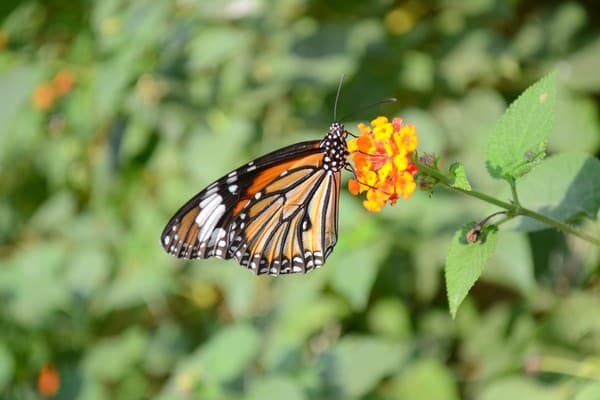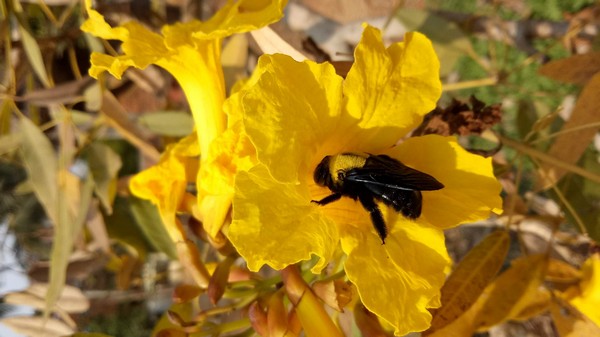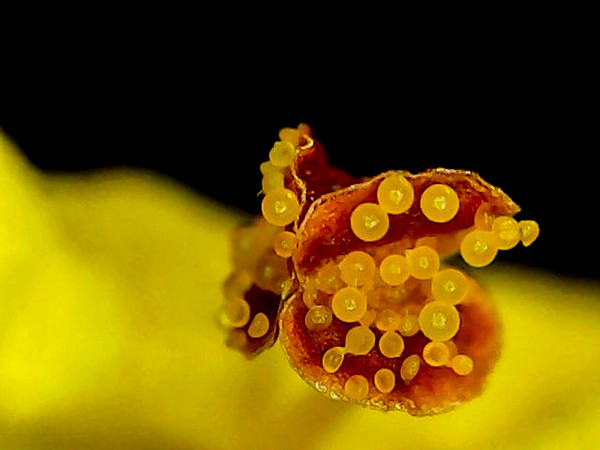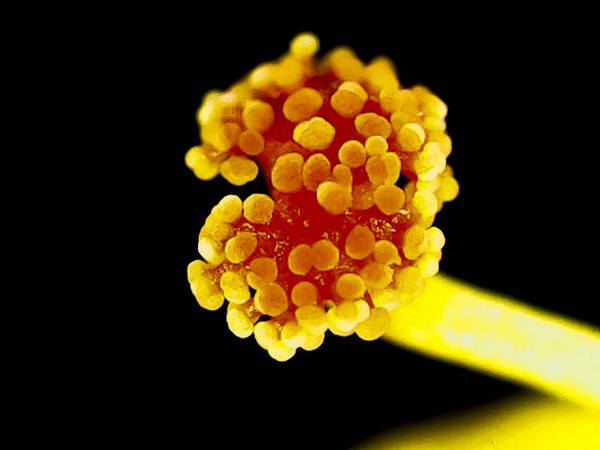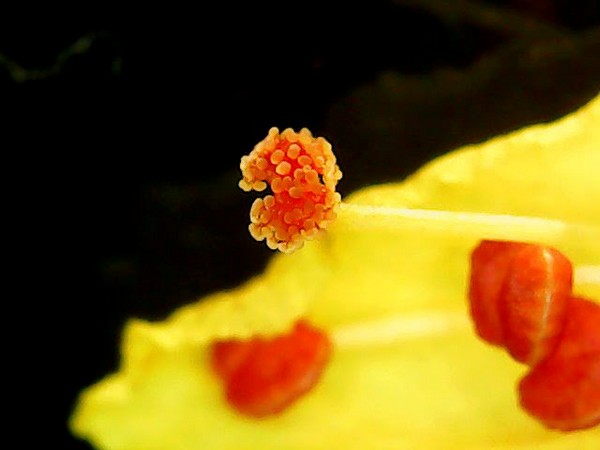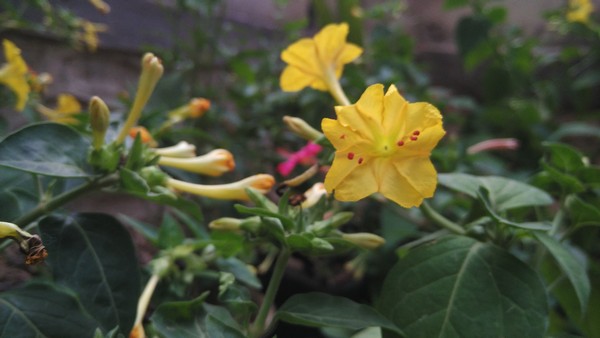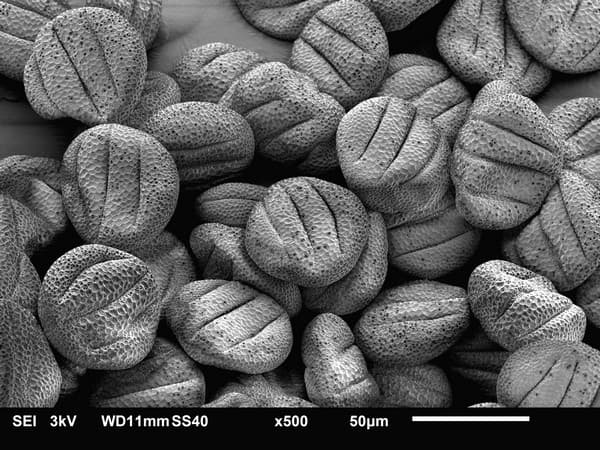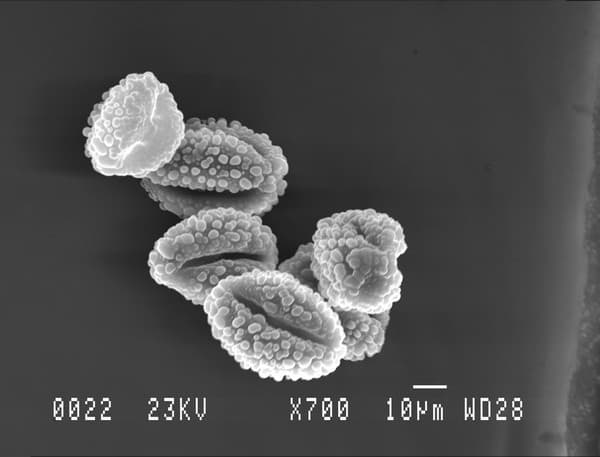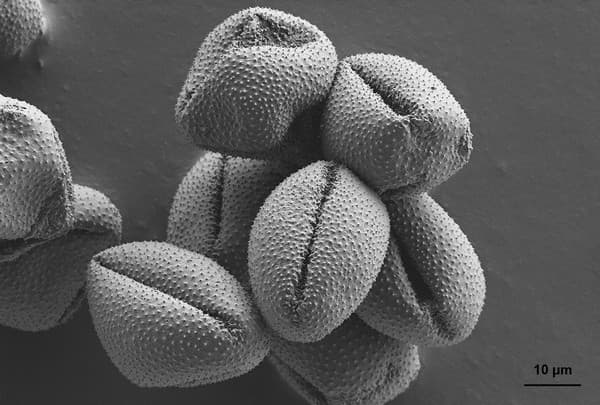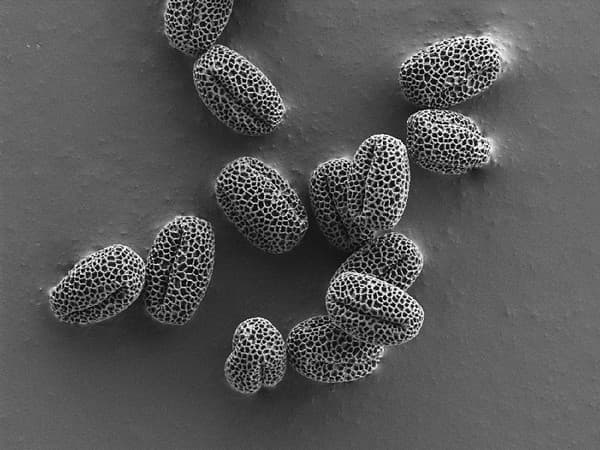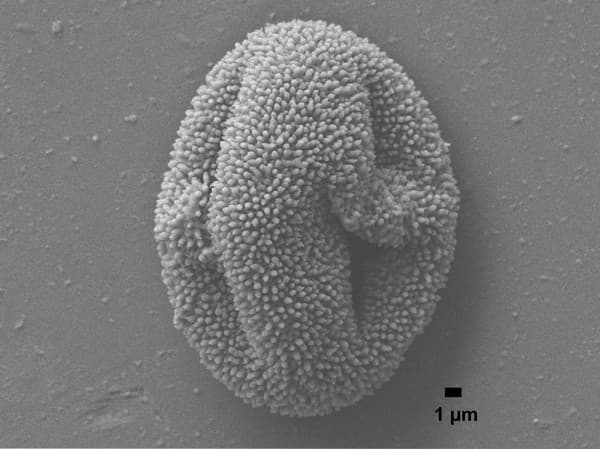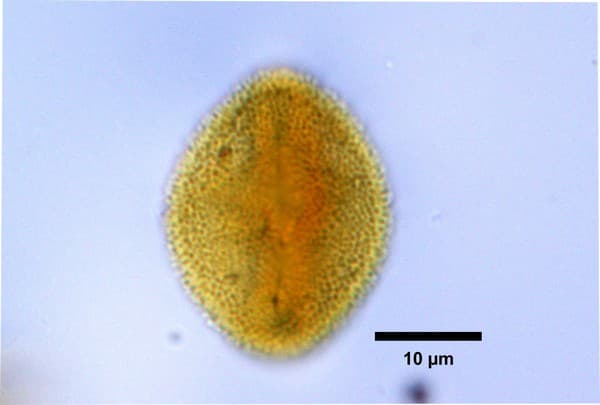“…until we turned to another book to find the age of the Earth, the one that was written in the rocks themselves.” – Astrophysicist Neil deGrasse Tyson in ‘Cosmos’
Beauty of fossils lies not only in the fact that they are ancient remains of creatures long gone, but also that they are irrefutable clues to evolution of life on the planet and the planet itself.
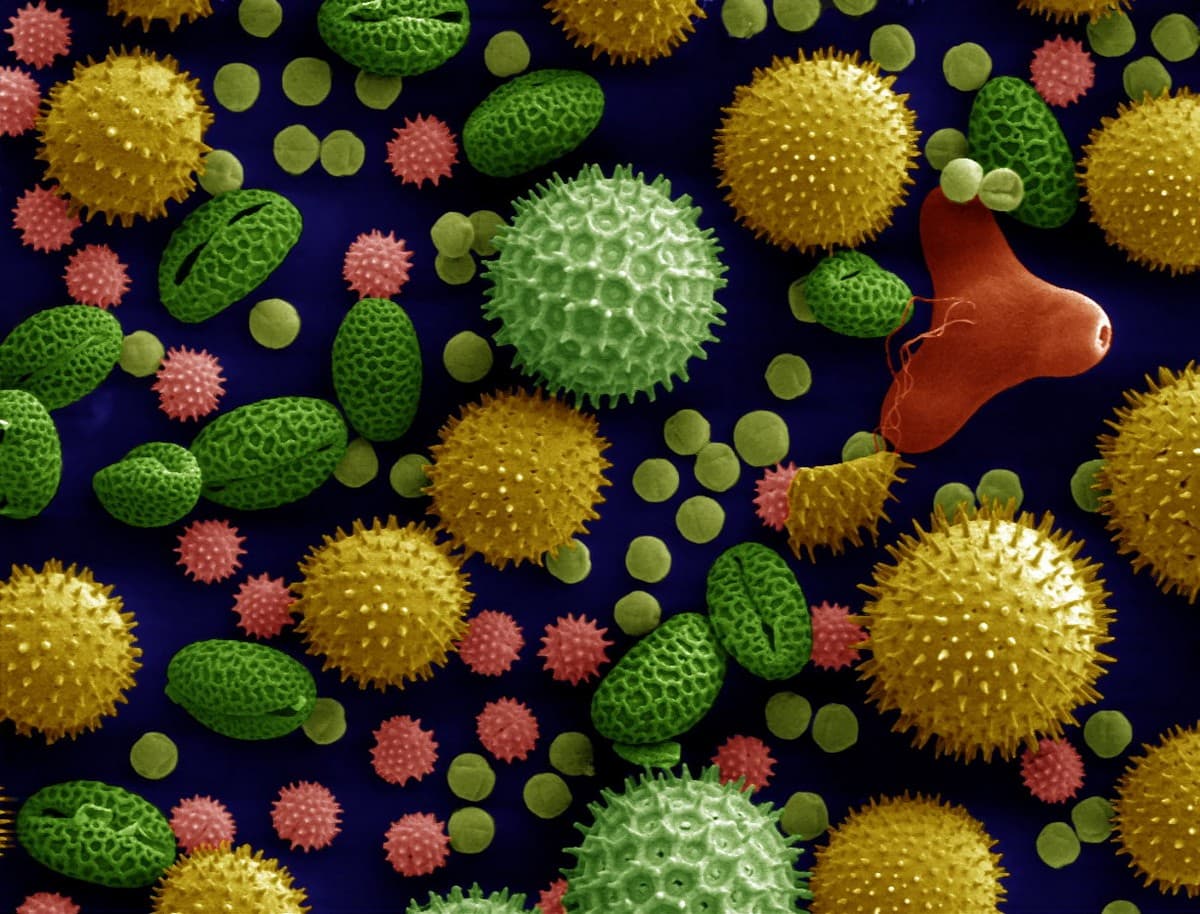
This representational image of miscellaneous pollen grains has been made using a Scanning Electron Microscope and is falsely coloured. The variety in shapes, sizes, and the intricacy of patterns on the outer wall is clearly visible. Photo Credit: Dartmouth Electron Microscope Facility_Dartmouth College/Wikimedia Commons. Note: These are not fosslised pollen.
Here, we look at a special kind of fossil tucked away in rocks, invisible to the naked eye, but that has the potential to help us ‘see’ the Earth’s past more clearly. These fossils allow us to find answers to thrilling questions such as what was the climate like when dinosaurs roamed the Earth, say about 70 million years ago? What kind of plants and vegetation made up the ancient habitats? How and when did flowering plants evolve from non-flowering plants? And so on.
Plants leave some special, indestructible traces of themselves behind, and have been doing so ever since they colonised land hundreds of millions of years ago. Leaves and flowers decompose and fossilise under tranquil environmental conditions and in smaller number. But the humble, microscopic spores and pollen grains are easily and abundantly preserved as fossils. And locked within the tiny fossil pollen are gigantic secrets relating to Earth’s glorious geological and biological past.
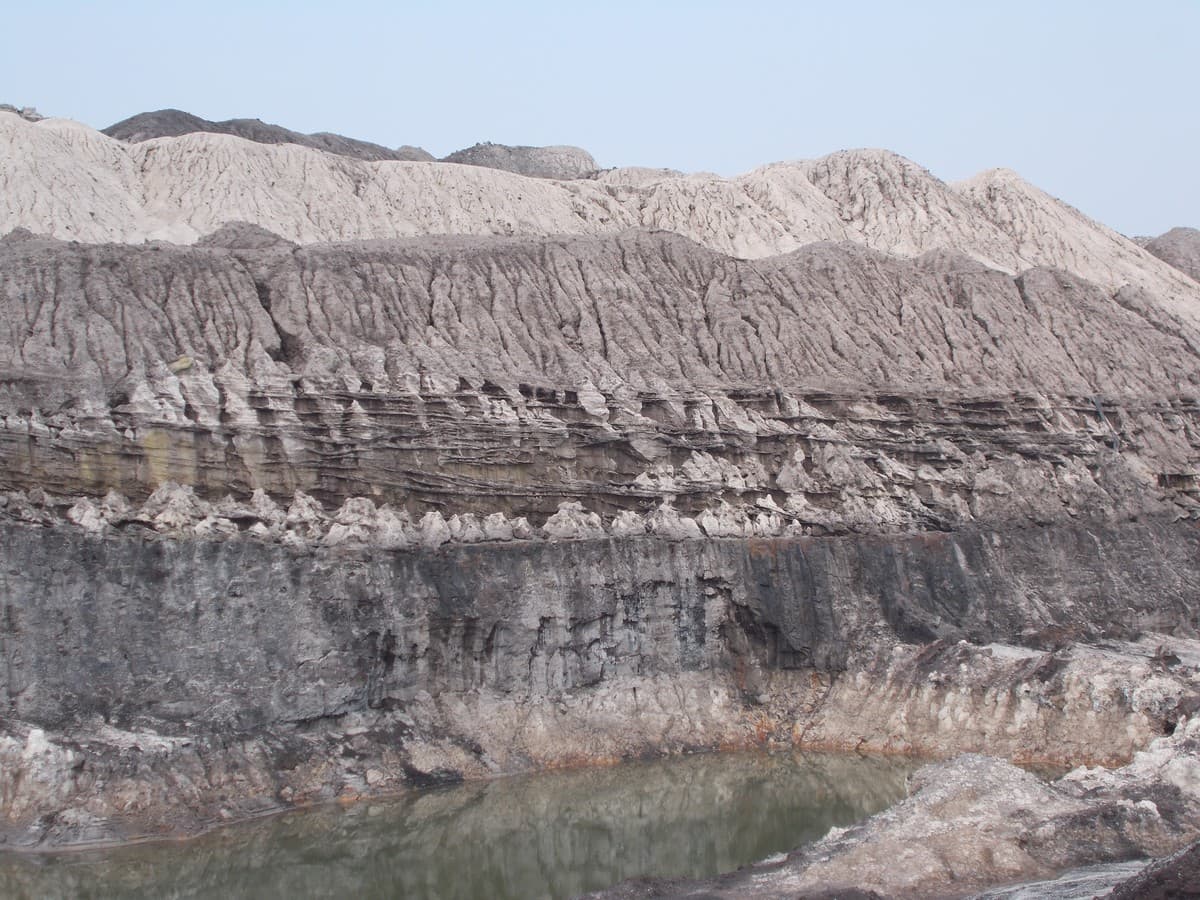
Fossils of various organisms can be found preserved within layers of rocks and these fossils help scientists to determine the relative age of rock layers or strata. Sonari Lignite Mine, Barmer Basin, Rajasthan, India. Photo Credit: Dr. Mahi Bansal
Indestructible Pollen!
Pollen grains are microscopic biological structures, ranging from 10 to 150 micrometers in size (one micrometer being 0.001 millimeter). They carry male gametes (sex cells) and are produced by both flowering (angiosperms) and non-flowering (gymnosperms) ‘higher’ plants for the purpose of sexual reproduction. Most plants recruit animals, usually insects, such as bees, butterflies, moths, etc. to be the agents of pollination i.e. transfer of pollen from male reproductive parts (stamen) to female reproductive parts (stigma) within the same flower or different flowers. Many plants also depend on wind and water for dispersal of their pollen. In the process, many pollen get scattered and settle on land and water only to be buried over time under debris of sediments.
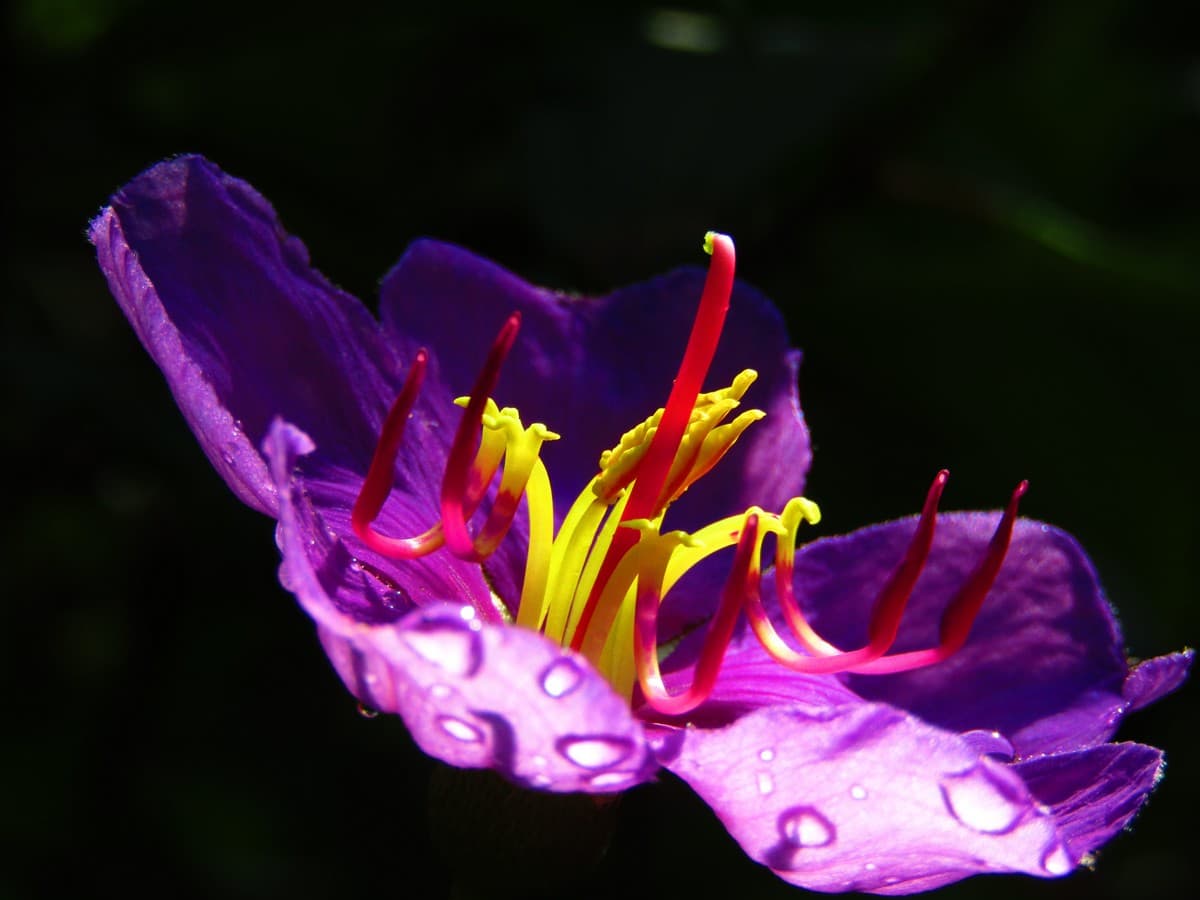
Flowers are essentially the reproductive structures of flowering plants (angiosperms). Flowers attract pollinators, such as insects, to pollinate their flowers and enable sexual reproduction. Flowers are an important source of food for pollinating animals. Image credit: Purva Variyar
Pollen grains are blessed with a very hardy exterior. This tough outer layer of a pollen grain is called exine. Exine is made of a highly resilient substance known as sporopollenin. It is this sporopollenin that gives pollen grains the incredible ability to withstand extreme weathering and allows them to be preserved in rocks for very long expanses of time. If not for this hardy exterior, the pollen grains would easily dry out and disintegrate, considering their diminutive size.
The male reproductive part of a flower called stamen consists of the bulbous anther at the top where the pollen develops. This collective of images made using a USB microscope shows (clockwise from top) pollen within an anther casing that has opened displaying the yellow pollen grains inside (top left), the pollen grains that have settled on a stigma (female reproductive organ) (top, right; bottom, left). The four-O’-clock plant flowers (bottom, right). Credit: Purva Variyar
Well-preserved fossil pollen grains dating back millions of years are abundantly found within layers of rocks and sediments deposited beneath the Earth’s surface. These microscopic, fossilised remains of plant pollen are true palaeontological marvels. They help palaeobiologists with generous clues that help them to reconstruct the evolution of terrestrial plants, ancient habitats and ecosystems, history of ever-shifting continental landmasses, and even Earth’s dynamic past climate!
Fossil pollen are ‘biological time capsules’ so to speak.
What Fossil Pollen Reveal?
Palaeobiologists have a lot to thank fossil pollen for. As the outer layer of the pollen gets fossilised and preserved, so do the intricate features and patterns within and on the pollen wall. It is these external features still visible on the fossil pollen that empower palaeontologists to wade back through history in deep time and find answers to the big questions. But how?
The scientists explore the fields and collect fossil samples from the outcrops like (ancient) lake beds and lignites. Then these samples carrying the pollen fossils are treated with strong chemicals to dissolve rock and other debris leaving behind only the highly resilient pollen fragments. Once the fossil pollen grains are isolated, they are observed under the light microscope or scanning electron microscope.
The intricate patterns and designs on the pollen wall are not random at all. Each type of plant produces pollen with signature shape and appearance. Most of these morphological characteristics of the pollen have remained steadfastly consistent since they first evolved, some remaining unchanged for more than 100 million years! Palaeontologists observe the physical characteristics of fossil pollen and compare them with the pollen of modern plants. Similarities observed tell them that the fossil pollen belongs to a plant closely related to a present-day species and that they possibly belong to the same family or sub-family. And different types of plants, as we know, will grow only in a specific environment with specific temperature and moisture requirements. So, fossil pollen can not only help us to know the kind of vegetation that a region once harboured, but also help to paint a picture of the past environments, habitats, and the climate!
External anatomy of pollen grains is highly specific to specific groups of plants. Each type of plant produces pollen with signature shape and appearance. Clockwise from top – Sage pollen, credit: Judyta Dulnik/Wikimedia commons; Pollen of an unidentified plant, credit: Purva Variyar; Pollen of rye grass, credit: Zeiss Microscopy/Flickr; pollen of olive tree, credit: Zeiss Microscopy/Flickr . Note: These are not fossilised pollen.
In 2013, discovery of 240-million-year-old fossilised pollen grains in Switzerland revealed the possibility of evolution of the flowering plants taking place at least 100 million years earlier than thought! This study showed flowering plants to have originated in the Early Triassic period, around the time earliest dinosaurs first appeared. Certain fossil pollen records from Patagonia, South America, have helped to find more pieces of the puzzle involving the rise and expansion of open-habitat ecosystems like the grasslands and savannas.
Fossil pollen have also helped scientists fill critical knowledge gaps relating to certain plant families whose pasts have been difficult to patch together. A fascinating example is that of the fossilised pollen grains belonging to the plants of the Asteraceae family, that were found preserved in Antarctica. The Asteraceae family comprises modern flowering plants such as daisies, sunflowers, chrysanthemums, dandelions, etc. The fossillised pollen showed that ancient plants belonging to this family were around as far back as the Cretaceous period, about 76-66 million years ago, when dinosaurs dominated the planet, and when Antarctica wasn’t so fully isolated from other landmasses and boasted of temperate forests and a warmer climate.
Indian Investigation
“Despite their tiny size, pollen pack a lot of information. They can even reconstruct the picture of the entire forests and provide information on the plants of the bygone eras. A lot of pollen recovered from the 60-50-million-year-old lignite of western India are comparable with the plants that are currently found in the Western Ghats. This illustrates how western India was once covered by the diverse and extensive forests that, surprisingly, is arid today,” says Dr. Mahi Bansal, Research Fellow at the Birbal Sahni Institute of Palaeosciences, Lucknow, India.
Dr. Mahi Bansal, along with other palaeoscientists at the Institute, has been studying fossil pollen samples of specific plants collected from various locales in India and comparing them with those found in other geographical regions across the globe. Through these studies, Dr. Bansal and others are attempting to understand how the angiosperm plant families evolved and adapted to different climatic conditions over millions of years before attaining their present distribution.
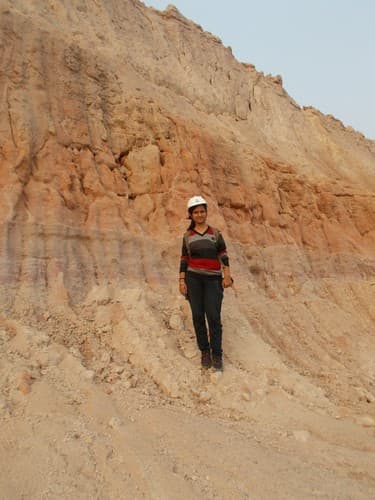
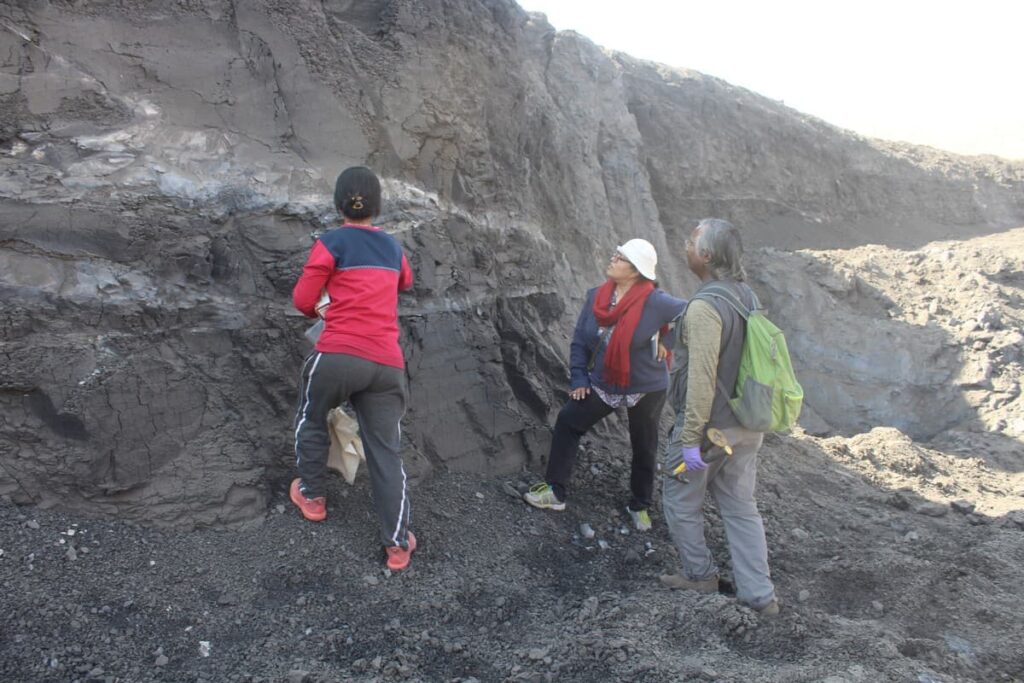
Dr. Mahi Bansal in the field (top) and with her team (bottom) collecting fossil pollen samples from rock layers. Courtesy: Dr. Mahi Bansal
In one such interesting study that was recently published, Dr. Bansal focuses on plants from sub-family Crotonoideae. Upon comparing the fossil pollen samples of ancient specimens of Crotonoideae plants collected in India, a striking similarity was found between them and the fossil pollen found in Africa and South America. This implies the origin of Crotonoideae at the time when Africa, South America, and India were close enough to facilitate the dispersal of the sub-family from one landmass to the other. In addition to this, several Indian pollen fossils bore resemblance to various living Crotonoideae plants that are today endemic to the forests of South America, Africa and Southeast Asia!
Two different images of a fossil pollen observed under Scanning Electron Microscope (left) and light microscope (right) identified as those belonging to species Terorchidium rubrivenium of the sub-family Crotonoideae within the plant family Euphorbiaceae. This fossil pollen specimen is dated to be 54 million years old and was unearthed from the Vastan Lignite Mine, Cambay Basin, Gujarat by Dr. Mahi Bansal and her team of researchers. Interestingly, this plant species is today endemic (only found in) to South America. Image courtesy: Dr. Mahi Bansal
Her study also showed how the Indian Plate, upon separating from the Gondwanan landmass approximately 120 million years ago, ferried various floral plants of different types on its journey from south of the equator to the north up until it collided with the Asian Plate approximately 55 to 34 million years ago. This grand collision gave rise to the Himalayan Mountain range and also resulted in a marked shift in the climate across the Indian subcontinent. Several plants which once dominated the Indian Plate went extinct due to the change in climate, while several other species adapted to the novel climatic conditions and some even spread further onwards to Southeast Asia. Thus, the array of native Indian plant species alive today are holdovers from an earlier, more diversified vegetation which were witness to these dramatic events and lived to tell the tale.
In one of the studies led by Dr. Bansal, her team has professed that tropical rainforest originated in Africa and as the Indian Plate moved from southern hemisphere to northern hemisphere receiving higher amount of precipitation, rainforest shifted to the Indian Plate, where most of the moisture-loving plants proliferated. A majority of plants even managed to survive the mass extinction event that led to the disappearance of non-avian dinosaurs from the Earth. The plants eventually dispersed to Southeast Asia after India-Asia collision, giving rise to the magnanimous Southeast Asian tropical rainforests.
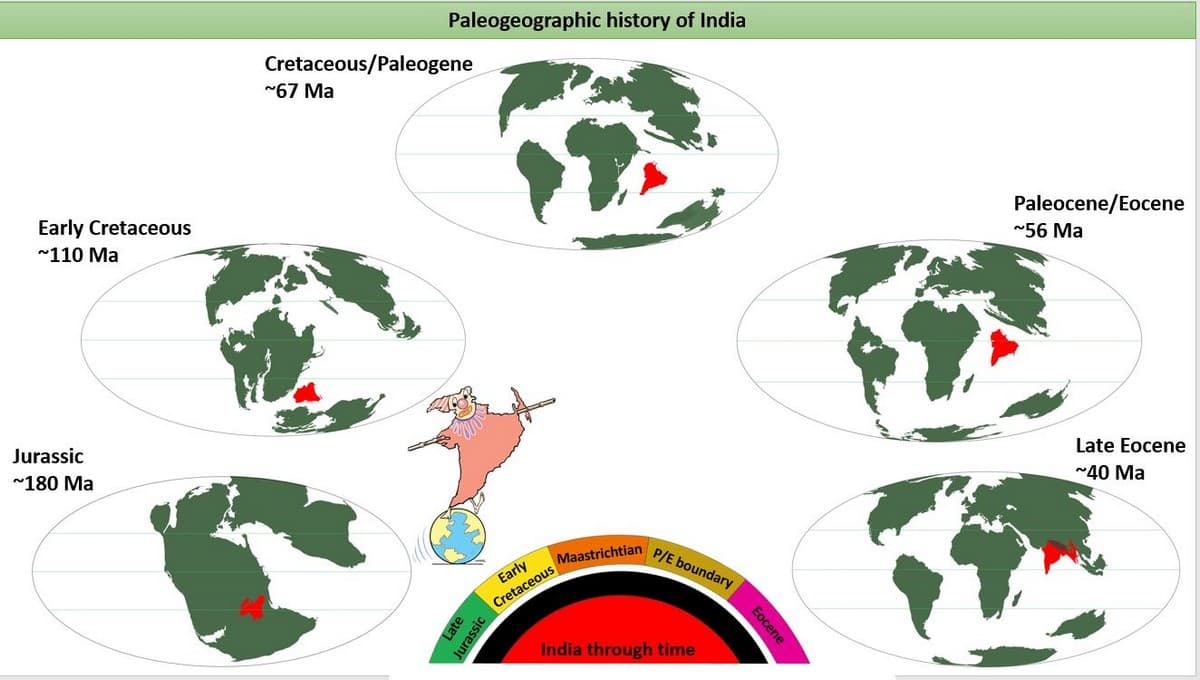
Courtesy: Dr. Mahi Bansal
“Pollen grains open windows millions of years into the past. Scientists can read the Earth’s past with the help of these micron-sized particles and thence comment on the future. The pollen grains trapped in the sediments can inform us about the ancient environments and climate. This information can be used to predict the upcoming climatic situation through climate modelling. That will ultimately help to answer today’s pertinent, existential questions, such as the impact of climate change on present-day forests,” Dr. Bansal concludes.
All this from pollen so small.
About the author: Purva Variyar is a conservationist, science communicator and conservation writer. She works with the Wildlife Conservation Trust and has previously worked with Sanctuary Nature Foundation and The Gerry Martin Project.
Disclaimer: The author is associated with Wildlife Conservation Trust. The views and opinions expressed in the article are her own and do not necessarily reflect the views and opinions of Wildlife Conservation Trust.
Your donations support our on-ground operations, helping us meet our conservation goals.
Related Links
- Why India’s Fossil Wealth Needs a Resurrection
- From Nothing to Quite Something – A Journey of a Snail Embryo
- Weird Connections – Part III
- Of Rock Shelters, Early Humans, and a Fossil
- Fossil Folklore

